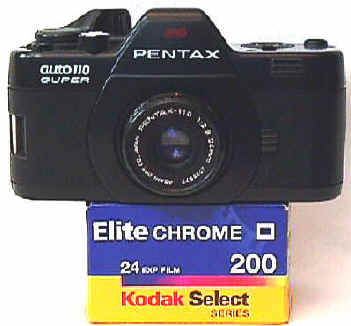 Pentax System 10:Largest
Subminiature System??
Pentax System 10:Largest
Subminiature System??Home Camera Articles FOR SALE Orders I Buy / Wants Repairs Books Adapters
 Pentax System 10:Largest
Subminiature System??
Pentax System 10:Largest
Subminiature System??
"System 10 is by far the smallest and lightest SLR ever made."
"System 10 lenses are so fine and so precise, that they can render a proper razor-sharp image on the 110 negative itself. They are fully capable of producing color images of outstanding quality. Not just at 8x10, but at 11" x 14" also. In terms of image quality, System 10 is the first 110 camera that can honestly be favorably compared to a 35mm SLR." Pentax Advertising, March 1979
Pentax 110's are fantastic little SLRs, in fact the smallest interchangeable lens SLR with TTL metering ever made. Styled like a very small 35 SLR, a body and three lenses can easily be held in the palm of your hand. Many people don't believe it's a working camera the first time they see one, mistaking the little Pentax for a toy. They offer true SLR focusing and viewing, programmed exposure, a choice of six different lenses, two different flashes, and a "motor-drive." On top of that, Pentax supported them with an entire system of accessories. So far as I know, this is the largest Sub-Miniature system ever. Pentax really tried to do the best job they could for the tiny new camera. Pentax promised quality enlargements up to 11x14. Frankly, most photo labs today are not up to this quality, but at least it's possible.
A Pro System? Well, I guess that depends upon how you make your money. I was once told about a photog who used his Pentax 110 to photograph guests on the Johnny Carson show, when cameras were strictly prohibited. He concealed it in the heel of his shoe to get past the inspection at the door. After the show he would rush to the Airport to send his film to the New York tabloids. It paid his bills, so I guess this can be a Pro System.
Introduced in late 1978, the tiny original Pentax Auto 110 really set the photo world on its ear. Nobody had ever seen a little system like this, nor has anyone made anything like it since. A rare clear body with see through body panels, fully functional, was made for dealer display, see separate profile.
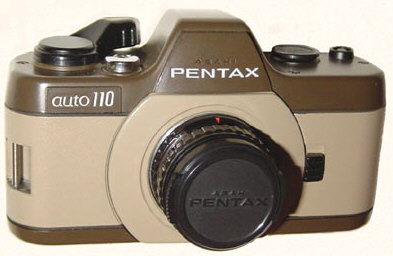 There was also the very handsome and rare
"Safari" 110, named after its color similarity to the Leica Safari R3.
It had tan top and bottom covers, with a green maroon
middle. The Safari came in a special little presentation case with its own special
tan suede EV case. I am not sure about the rest of the world, but Pentax USA
told me that the Safari model was never officially imported to the US. It was used
instead as a presentation item to selected dealers and company officials. Safari pic
courtesy and copyright of Paul Coltoff.
There was also the very handsome and rare
"Safari" 110, named after its color similarity to the Leica Safari R3.
It had tan top and bottom covers, with a green maroon
middle. The Safari came in a special little presentation case with its own special
tan suede EV case. I am not sure about the rest of the world, but Pentax USA
told me that the Safari model was never officially imported to the US. It was used
instead as a presentation item to selected dealers and company officials. Safari pic
courtesy and copyright of Paul Coltoff.
Pentax Auto 110 specs include shutter speeds from 1 sec to 1/750th, an exposure range of EV 3 to 17 at ASA 100, aperture ranges from f/2.8 to f/13.5, a silicon photo cell rather than the less sensitive CDS that was more in use at the time. The Auto 110 was also able to index itself for the new ASA 400 film. For the lower film speed setting, the camera would key itself to ASA 80. Centerweighted metering system. While the finder is small by 35mm standards, it is huge by 110 standards, and easy to focus with excellent contrast. Its two AA battery powered winder propelled film though at an astounding single frame per second. It works one frame at a time, and can not be used for sequential shooting. In a strange bit of camera design, the Auto 110's electronics are turned off by depressing the shutter release slightly, until some resistance if felt. Of course virtually everyone forgets about this since it's not marked on the camera.
The improved Super was introduced in 1983 when 110 sales were already in their swan song. Comparatively few Supers were sold. In my own experience, I encounter about one Super for every 30-40 of the original version I see. Luckily both cameras all used the same lenses, accessories, and common D76 batteries. The exception is the Winder II which was made only for the Super. How to tell the difference? The Super is labeled on its front plate, the original has no label.
What made the Super, Super?? While the same size as the original 110, the Super boasted 1) a single stroke advance instead of two 2) a labeled shutter lock 3) a 10 second LED self timer 4) a brighter focusing screen 5) a microprism around the split image rangefinder 6) 1.5 stop back light compensation button 7) the Winder II which was capable of continuous shooting 8) Flash connection cover now hinged to top plate to lesson chances of loss 9) shutter released has a guard around it to lesson chance of accidental release 10) minimum exposure is 1/400th at f/18 rather than 1/750th at f/13.5 Whether this change occurred to improve shutter reliability, or increase depth of field, is unknown. 11) A green LED in the finder indicates a shutter speed of 1/45th or faster, a yellow LED a shutter speed slower than 1/45th, rather than the 1/30th cut off in the original 110.
The .75x size viewfinder shows 87% of the picture area. The shutter speed range is 1/400th second to 1 second, controlled by a Silicon photo cell.
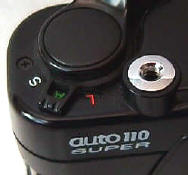
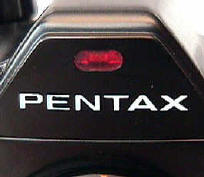
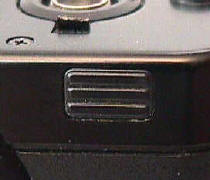
The shutter lock and self timer control were located on a switch built on the advance lever. The red LED above the Pentax logo flashed to signal self timer operation. The plastic pad was the backlight compensation switch.
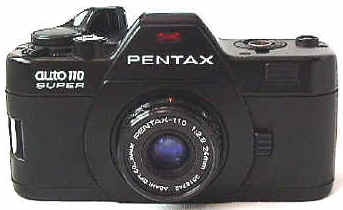
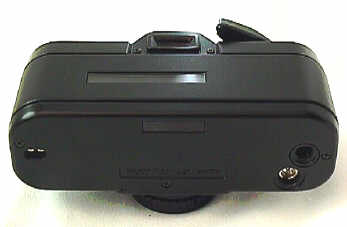
The little button on your right of the lens is the lens release. Note the bottom motor connections. The built in plastic cover for the flash connection is broken off on this particular example, as they often are.
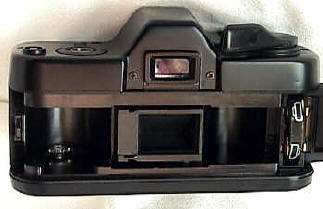
Both the Super and Original featured very easy drop in 110 cartridge loading. The pic at the right shows the two D76 batteries in their holder. If you look closely below them into the camera body, you will see a little plastic finger extending above that ledge. That keyed the camera to ASA 400 film. IF the film cartridge pressed down that little finger, the meter was set at ASA 80. Unfortunately, 110 cameras were designed to have a maximum of two film speeds choices for the meter. Battery life was estimated at 10,000 exposures or one year, whichever occurred first.
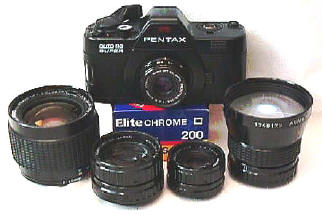
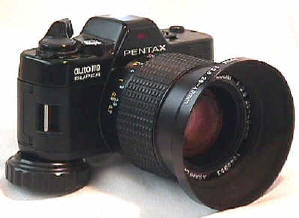
Family portrait with Super and all five prime lenses. Lenses available included the six element 18/2.8 wide angle, the low cost and now collectible fixed focus 18 mm "pan focus," the six element 24/2.8 normal, the five element 50/2.8 portrait lens, the hard to find six element five group 70/2.8 long telephoto, and the very hard to find eight element in eight group 20-40/2.8 zoom. Collectors fill out their shelves with the very useful Soligor 1.7x Teleconverter. Doubling the focal length of the Pentax 110 lens tells you its equivalent in 35mm, so the System 10 lens range covers the equivalent of 35mm wide to 140 telephoto in 35mm terms. Strangely enough, Pentax never marketed a tele-converter for System 10, at least not in the United States.
The 20-40 zoom, 70/2.8, and Pan focus 18 were introduced late in production at the 1980 Photokina. This helps explain their relative rarity. Judging from the shape of the reflections of the glass, the 20-40 apparently uses an aspherical element. Surprisingly, it's not unusual for Pentax to use Aspherical designs and NOT publicize it.
To the right see the ultra rare 20-40 Zoom and its even rarer metal shade. Notice the tripod adapter mounted to the camera. This was necessary for the 50, 70, and 20-40 Zoom on a tripod.
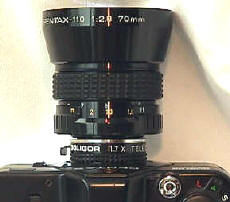
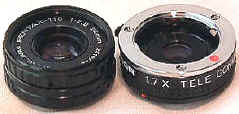
The rare Soligor 1.7 Teleconverter turned the 70mm into a 119 mm lens, or roughly equal to a 238 mm lens on a 35mm.
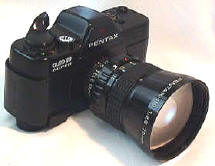
Pentax offered a comprehensive system of accessories. One of the most useful, and harder to find is the belt clip.
The 110 Super Winder II offered continuous shooting at a blazingly fast 1.5 frames per second! So far as I know, this winder has the honor of being the ONLY electric accessory winder made for Sub-miniature cameras. I love the styling of it -- and of the camera itself for that matter -- just like a "Grown UP" SLR!
Warning Will Robinson! Danger! Danger!
The most breakable part of the 110 System is the little plastic battery covers on the motor drives. Now, in what is probably a CameraQuest exclusive, you see published for the first time in detail, these diabolical little demons.
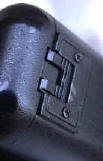
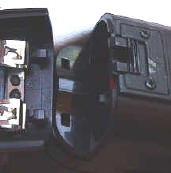
On the left you see the battery latch on the bottom of the motor drive. Push it towards the motor handle, and the cover opens. The often overlooked part is that the cover has two little legs (2nd pic) which must be positioned before closing the top. Otherwise you are likely to break the battery cover, and join the sleepless legions of System 10 battery cover seekers, condemned to pathetically haunt camera stores begging for the unobtainable replacement battery covers. By the way, if you recognized the famous warning lines of the old TV Lost in Space series, it is considered legal proof in 58 countries that you wasted your youth watching too much TV.
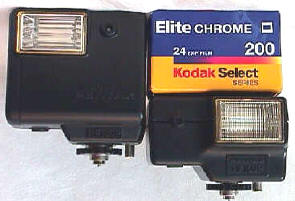
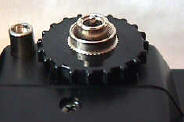
Flashes: The more common flash is the larger AF130P powered by two AA batteries. It has a stated flash range of 2.6 to 15 feet with either ASA 100 or 400 film for the Super. Exposure was automatically set by the camera. The Guide Number was 13 with ASA 100 in meters. ASA 100 films automatically set the camera to f/2.8 and a shutter speed of 1/30th. ASA 400 films automatically set the camera to f/5.6 and 1/30th second. Turning on the flash activated these settings, just an attached but un-powered flash would allow the camera to be used normally. The smaller AF100P flash is powered by two AAA batteries has a Guide Number of 10, ASA 100 in meters. Its stated effective range is 2.6 to 12 feet. It uses the same shutter speed and f/stop settings as the larger flash. Both flashes have a standard recycle time of about 7 seconds. The smaller size of the AF100P is much more in keeping with the small camera size, though this smaller flash is much harder to find. Notice the unique flash connection. I suppose it would be possible to remove the connectors off a flash and adapt a larger flash to the camera.
Accessories, We have Accessories! Pictured are the belt clip, body cap, front and rear caps, the viewfinder cover for self timer operation on a tripod, the tripod adapter for the 50, 70, and zoom lenses, and the nifty elegant hand strap.
Accessory filters play an important part of the Pentax 110 System. Of course all lenses had the usual UV and skylight filters, but the killer filters were the neat close-ups! Close-up filters could be combined for even closer pictures. I know of no other sub-miniature system which had a close-up system even approaching the Pentax 110's.
Lens Filter Focus Range Ratio
18/2.8 W21 Close-up 16-26 cm 1/5.7-1/11.3
24/2.8 S31 Close-up 20-36 cm 1/6.1-1/12.7
24/2.8 S16 Close-up 15-20 cm 1/4.1-1/6.4
50/2.8 T26 Close-up 48.5-91.9 cm 1/8.0-1/17.1
50/2.8 T43 Close-up 34.4-48.9 cm 1/5.4-1/8.6
Pentax System 10 Design: In 1977 a freelance Japanese camera designer named Sugaya showed his prototype Sugaya Micro F EE 110 SLR. It was probably the first 110 SLR with interchangeable lenses. The Sugaya had a thread mount 33/2 lens, 1-1/500 shutter speed range, a CDS metering system, weighed 9 ounces, knob wind, and appeared to be a scaled down 35mm SLR. Apparently the basic design was sold to Pentax. The Pentax R&D department then improved it, under the leadership of M. Suzuki.
Interestingly, Pentax 110 lenses do not have diaphragms. The cameras had a special combined shutter and aperture mechanism which sets both, behind the lens. Though I have yet to do it, I have long suspected that as long as you can fabricate a mount out of a damaged lens, the cameras should function fine with virtually any f/2.8 lenses adapted to them. By varying the maximum f/stop from the f/2.8 the camera is designed for, you would also have a form of exposure compensation.
Accurate ASA Film settings are a bit of a problem with Pentax 110's (and many other 110's). Both the Auto 110 and the Super had the necessary activating pin to be set for either ASA 80 film or ASA 400. The problem is that today, the only emulsions still available are color negative 200 and 400, and most film cartridges seem to be indexed for the lower speed film. If you are shooting with 400 film and the camera thinks its 80, you get an automatic 2 1/3 stop overexposure on a very small negative. It makes for dense, grainy negs--not what you really want if you value tonal values or sharpness. Luckily the solution is to file away part of the film cartridge, so your camera uses the higher film setting!
Film choices are getting to be thin in 110 today, though if you are dedicated enough, you can reload 110 cartridges. This is thoroughly discussed at http://members.aol.com/xkaes/110.htm. Luckily, the Pentax 110's are among the few 110's that will work with reloaded film. The 110 negative measures 13mm x 17mm, or roughly 1/4 of the 35mm negative. 110 film is 16mm film, but with a single and different perforation pattern. Today's improved films have the capability of giving results far better than the films available when the Pentax 110 was introduced.
An interesting design point is that the ACTUAL 110 film speed setting was left up to the camera manufacturers. All Kodak did was to make standard two ASA settings for medium and fast films. It was up to the camera designer to decide what those film settings would actually mean to the camera. Pentax used ASA 80 and 400. Some manufacturers used 100 and 250 (the actual speed Kodak is said to have intended for the higher index). So, to get really accurate exposures, it pays to know your film cartridge and your camera.
So What's So Special about the Pentax 110's?
Nothing...its just a camera. And everything.
If you want an interchangeable lens SLR with TTL metering, smaller than most 35 SLR flash units, you literally have NO other choice. Enjoy.
Brief 110 History: Never has any film format been so popular so quickly, only to fall out of favor so quickly.
Kodak introduced 110 film in 1972, amid much advertising hoopla for this new, smaller, more convenient consumer format. The original Kodak 110 lineup consisted of the Kodak Pocket Instamatic 20, 30, 40, 50 and the top of the line 60 with rangefinder focusing . A big selling point was the Pocket Instamatic's long thin design to allow easy carrying in shirt pockets or purses. "Pocket Instamatic," get it? Those clever folks at Kodak always love great ad slogans. As popularity soared, many photography magazines carried articles wondering if the success of 110 would mean the demise of 35mm ( like APS articles a few years ago---HA HA HA).I've read that that over 100 million 110's were produced (and are still being produced) in hundreds if not thousands of different designs. No one really seems to be sure what ALL the different models are. No "110 Book" of ALL models with production figures has ever been published. Most of course, were inexpensive low end snapshot cameras. Today 110 cameras offer the collector a virtually untapped area, with hundreds of different, often inexpensive, cameras to fill out their collection. European and Japanese designs which weren't exported add to the collector's possibilities.
Of the hundreds of different 110 cameras marketed in the US, only a few really stand out. The first three listed are my own favorites.
Pentax 110 and Super: the smallest SLRs and by far the largest 110 system -- and the most popular 110 camera today.
Rollei A110 and E110: among the smallest and most elegant 110 cameras, a beautiful design. Programmed operation in the A110, aperture priority in the much harder to find E110. scale focusing.
Minox 110S: the best RF 110 in my opinion, with aperture priority, wonderful VF/RF for a 110.
Canon ED and ED20: the fastest lensed RF's with f/2 lenses, well made with lots of features, but rather large and heavy for a 110.
Minolta 110 SLR's: Mark 1 and II. Both had fixed zooms and are inordinately large for 110's. Surprisingly popular.
Kodak 60 and 48: the Best Kodak RF 110's, very low cost today relative to their new cost.
Kodak708: a neat design with two lenses built in, a normal and tele, hard to find.
Kodak Ektramax: probably the first production camera with a fixed Aspherical lens, a 25/1.9 in 1978. Strangely it had no meter, and was intended for manual exposure with a limited set of f/stops and shutter speeds. Despite its very interesting features, it had the disadvantage of being very large for a 110. hard to find.
Of the millions of 110 cameras, probably less than 10% of them, maybe less than 5%, had built in metering. Most were very simple fixed aperture cameras with a very limited list of photog choices. Since 110's were designed for the rank beginner amateur market, it's not hard to figure out why local film processors had so much trouble with 110 film. The exposures were all over the place on a small negative. Underexposure gave dim dark prints. Overexposure increased grain and decreased sharpness.
Besides the exposure problem, there were always suspicions that 110 cartridges failed to hold the film flat, though I have never seen any official reports to that effect.
Faced with mediocre results from low cost cameras and processing, 110 popularity noticeably started to decline as soon as 1976. By 1977, despite all the predictions of amazing new cameras, new designs started to dwindle to a trickle. The American photo publication Petersen's Photographic started a 110 column in March of 1975. In January 1978, the column was discontinued because it was obvious from declining sales and lack of new models that 110 was going nowhere. Pentax System 10 was not introduced until 1978, when 110 was already on the decline.
At one time 110 film variety rivaled 35mm, including fast and slow B/W emulsions, Kodachrome, Ektachrome, fast and high speeds color negative films. Today only 200 or 400 ASA color films are easily available...at least so far as I know. This is a problem for the best results, since virtually no 110 cameras are calibrated for 200 ASA film. It may be possible to have your top of the line 110 re-calibrated, but you have to wonder if it's really worth the time and expense, especially with small APS cameras and film being readily available.
Today 110 information is relatively hard to find. The only 110 book I know of was amazingly titled "110 Photography," in soft cover published by Petersen's Photographic in 1976 by Kalton Lahue.
Home Camera Articles FOR SALE Orders I Buy / Wants Repairs Books Adapters
Revised: November 26, 2003 . Copyright � 1998-2002 Stephen Gandy. All rights reserved. This means you may NOT copy and re-use the text or the pictures in ANY other internet or printed publication of ANY kind. Information in this document is subject to change without notice. Other products and companies referred to herein are trademarks or registered trademarks of their respective companies or mark holders.